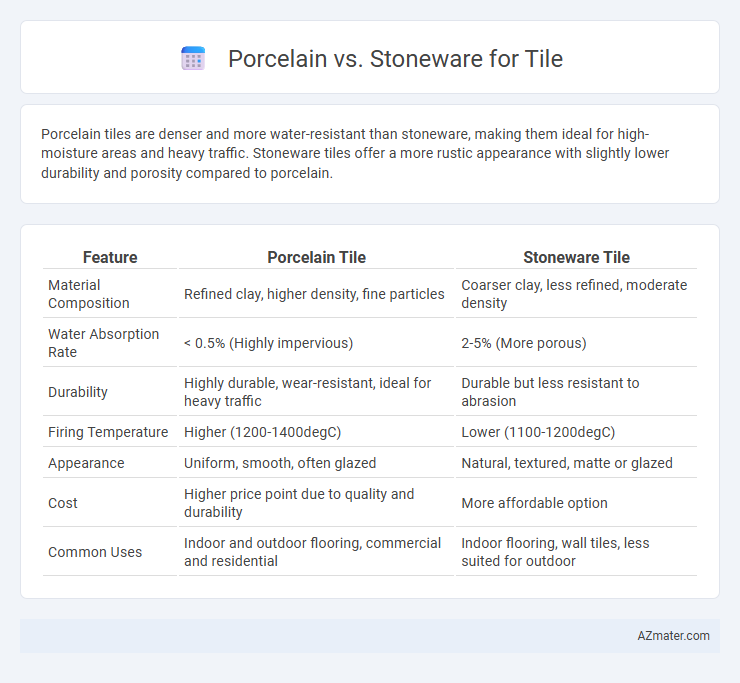Porcelain tiles are denser and more water-resistant than stoneware, making them ideal for high-moisture areas and heavy traffic. Stoneware tiles offer a more rustic appearance with slightly lower durability and porosity compared to porcelain.
Table of Comparison
| Feature | Porcelain Tile | Stoneware Tile |
|---|---|---|
| Material Composition | Refined clay, higher density, fine particles | Coarser clay, less refined, moderate density |
| Water Absorption Rate | < 0.5% (Highly impervious) | 2-5% (More porous) |
| Durability | Highly durable, wear-resistant, ideal for heavy traffic | Durable but less resistant to abrasion |
| Firing Temperature | Higher (1200-1400degC) | Lower (1100-1200degC) |
| Appearance | Uniform, smooth, often glazed | Natural, textured, matte or glazed |
| Cost | Higher price point due to quality and durability | More affordable option |
| Common Uses | Indoor and outdoor flooring, commercial and residential | Indoor flooring, wall tiles, less suited for outdoor |
Understanding Porcelain and Stoneware Tiles
Porcelain tiles are made from finer, denser clay fired at higher temperatures, resulting in a harder, more water-resistant surface ideal for high-traffic and moisture-prone areas. Stoneware tiles use coarser clay and lower firing temperatures, producing a more porous, textured finish suited for indoor spaces with moderate wear. Understanding the material composition and firing process helps differentiate porcelain's durability and moisture resistance from stoneware's rustic aesthetic and breathability.
Key Differences Between Porcelain and Stoneware
Porcelain tiles are denser, less porous, and more durable than stoneware, making them ideal for high-traffic areas and outdoor use. Stoneware tiles have a thicker body and a more rustic, textured finish with higher water absorption, which limits their suitability for wet environments. The firing temperature also differs, with porcelain fired at higher temperatures (above 1,200degC) compared to stoneware, resulting in greater strength and resistance to wear.
Durability Comparison: Porcelain vs Stoneware
Porcelain tiles exhibit superior durability due to their dense, non-porous composition, making them more resistant to wear, moisture, and staining compared to stoneware tiles. Stoneware, while still durable, is more porous and may require sealing to prevent damage from water absorption and everyday use. The hardness of porcelain, rated higher on the Mohs scale, ensures better resistance to scratches and chipping, making it ideal for high-traffic areas.
Water Absorption and Porosity
Porcelain tiles exhibit significantly lower water absorption rates, typically less than 0.5%, due to their dense and vitrified composition, making them highly resistant to moisture and ideal for wet areas. Stoneware tiles have higher porosity and water absorption, usually between 3% and 7%, which can make them more susceptible to staining and water damage without proper sealing. The low porosity of porcelain enhances durability and frost resistance, while stoneware requires additional treatment to improve its moisture resistance.
Aesthetic Options and Styles
Porcelain tiles offer a wide range of aesthetic options, including sleek, polished finishes and realistic stone or wood looks, making them ideal for modern and contemporary styles. Stoneware tiles feature a more natural, rustic appearance with earthy tones and textured surfaces, perfect for traditional or farmhouse-inspired designs. Both materials provide versatile style choices, but porcelain excels in mimicking high-end materials with precision and durability.
Installation Challenges and Considerations
Porcelain tiles, known for their dense composition and hardness, require specialized cutting tools such as diamond blades and slower drilling speeds, posing challenges during installation compared to the more forgiving nature of stoneware tiles. Stoneware's lower water absorption rate and natural variability demand careful substrate preparation and consistent grout sealing to prevent moisture infiltration and staining. Installers must account for porcelain's heavier weight and potential for chipping, while stoneware requires attention to ensure flatness due to slight warping risks.
Cost Comparison and Value for Money
Porcelain tiles typically cost more upfront than stoneware due to their density, durability, and water resistance, making them ideal for high-traffic areas and outdoor use. Stoneware offers a more budget-friendly option with good aesthetics and moderate durability, suitable for indoor applications with less wear. Evaluating value for money involves considering long-term maintenance and replacement costs, where porcelain's longevity often justifies its higher initial price.
Maintenance Requirements and Longevity
Porcelain tiles offer superior durability and lower maintenance requirements compared to stoneware, resisting stains, scratches, and moisture with minimal sealing needed. Stoneware tiles, while aesthetically unique due to their natural clay composition, require regular sealing to prevent water absorption and are more prone to chipping over time. Porcelain's denser composition ensures longer lifespan and consistent performance in high-traffic areas, making it a preferred choice for both residential and commercial flooring.
Ideal Applications for Porcelain Tiles
Porcelain tiles excel in high-traffic areas due to their dense composition and low water absorption rate, making them ideal for kitchens, bathrooms, and outdoor spaces. Their durability and resistance to scratches and stains make them perfect for commercial settings and residential floors requiring long-lasting performance. Porcelain's ability to withstand extreme temperatures and moisture also suits it for use in swimming pools and heated floors.
Best Uses for Stoneware Tiles
Stoneware tiles excel in high-traffic residential spaces like kitchens and bathrooms due to their durability and resistance to moisture. Their slightly porous surface makes them ideal for indoor applications where slip resistance is important and adds a natural, rustic aesthetic. Compared to porcelain, stoneware offers warmth and texture, making it well-suited for flooring and walls in areas demanding both functionality and style.

Infographic: Porcelain vs Stoneware for Tile
 azmater.com
azmater.com